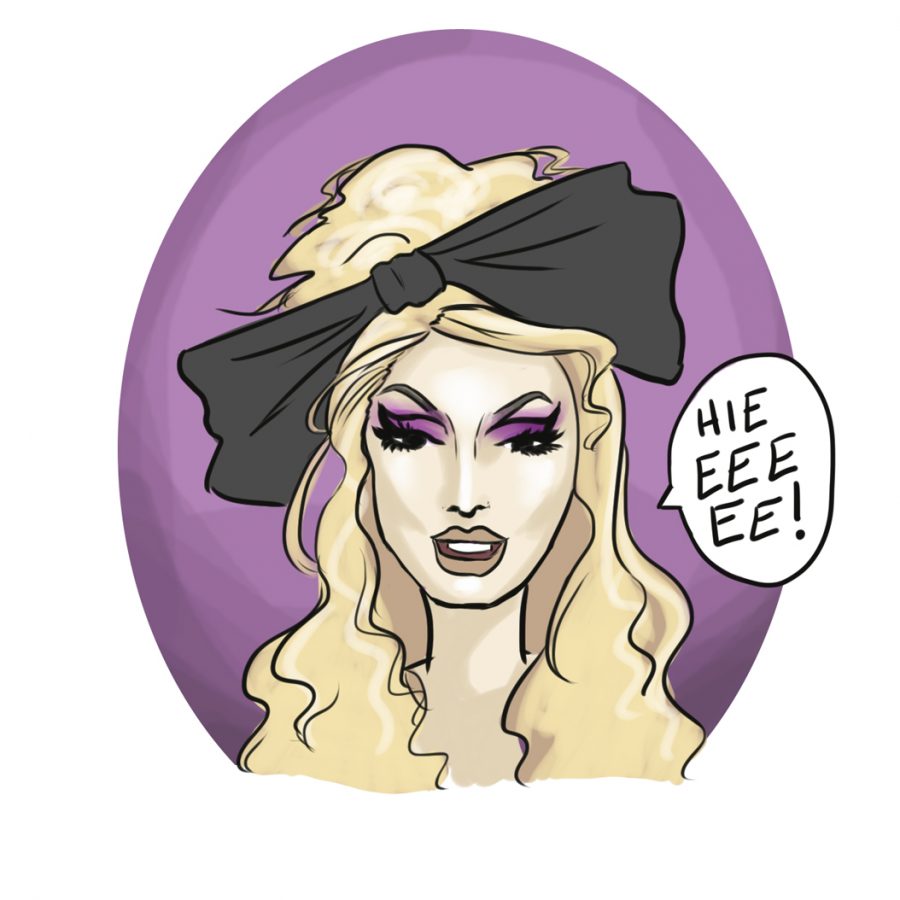In drag culture, sometimes you have to embrace extravagance.
At Pitt Rainbow Alliance’s Panther Drag event Sept. 17. — which takes place annually in the William Pitt Union — students drew their drag names on coloring boards, tried on different styles of makeup and, of course, walked the runway in dazzling colors and materials.
Pitt is an enthusiastic audience for drag — the act of dressing and performing as the opposite gender — as Peter Crouch, president of Rainbow Alliance, well knows. According to Crouch, almost 300 people were in attendance at this year’s show.
“We can tell from even the promotion stage before drag events that they are super popular for students,” Crouch said.
In general though, drag stands at a crossroads of American culture, the intersection of the mainstream and the underground: too bizarre for venues outside the nightclub scene, yet popular enough to deserve Emmys. Drag — both at Pitt and on the national level — is close to becoming a more mainstream form of entertainment. But with larger social attitudes still shying away from gender fluidity, it’s not there quite yet.
The excitement for drag at Pitt isn’t just a trend sparked by the popularity of the competitive reality show, “RuPaul’s Drag Race.” Rainbow Alliance has hosted an annual drag show since 2000, nine years before the first season of “Drag Race” aired. Past drag shows at Pitt have even been the stomping ground of future “Drag Race” contestants.
Pitt alumnus Justin Honard, now better known as Alaska Thunderf*** 5000, performed for some of her first audiences at the Rainbow Alliance drag show before being selected for the fifth season of “Drag Race.” This was in addition to recently winning season two of “All Stars Drag Race” earlier this month.
The supportive and inclusive atmosphere at Pitt is without a doubt a factor in the success of campus drag events. In an interview with Madison Scull for Pitt online publication Fresh U, Marcus Robinson, former president of Rainbow Alliance, said that Pitt has supported the LGBTQ+ community for the past several years.
“Pitt has created a space for LGBTQIA+ students to organize and promote a key part of LGBTQIA+ culture, driven by an undergraduate LGBTQIA+ student organization,” Robinson said. “[I do] not know of any backlash surrounding [the drag show], at least in regards to the last five or six years.”
Drag’s enjoyed a similar level of mainstream approval on a national scale. Ratings for the latest season of “All Stars Drag Race” smashed records on Logo TV, its host network, with a 35 percent viewership increase from the previous season and over 15 million viewers across all platforms. This came on the heels of RuPaul’s September Emmy win for hosting “Drag Race.”
With “Drag Race” enjoying such levels of mainstream success — including an Emmy award, the ultimate recognition from mainstream television — can we still say drag lies outside of the “mainstream?”
To answer this, we first need to define “mainstream.” Lanei Rodemeyer, a professor of philosophy at Duquesne University, said mainstream means what a culture generally does during day-to-day life. But that carries an implication about what it means to live in modern society.
“The term ‘mainstream’ refers to what ‘most’ people do, how they live their lives, or the abilities that ‘most’ people have,” Rodemeyer said. “[The term ‘mainstream] often also employs a moral implication that everyone ‘should’ be the way ‘most’ people are.”
Under this definition, drag is far from mainstream. “Most” people do not do drag, and many people still disapprove of it as an art form. They are the “matrix,” as RuPaul calls them, referring to Americans who still have rigid views on gender.
The audience for drag is not small, and by all evidence growing, but the “matrix” of those uncomfortable with gender play are the “mainstream.” Most people don’t do drag, therefore, as Rodemeyer mentioned, there is a moral implication that the rest of us shouldn’t either.
Since drag fundamentally toys with these rigid gender roles, Rodemeyer notes that drag could also be understood as a critique of mainstream gender presumptions.
“If that is what drag is, then it must in some way always stand ‘outside’ of mainstream in order to critique it,” she said.
Fortunately for the future of the art form, its main audience is not only growing, but young. Especially since drag centers on nightclub performances, the below-40 crowd are the primary consumers of drag culture. In Pittsburgh, several venues host drag shows on monthly or weekly bases, including Blue Moon in Millvale and Cruze Bar and Cattivo in the Strip District.
The supportive environment of a college campus doesn’t always reflect reality, but the “matrix” RuPaul talks about is becoming more and more relegated to the older generations in America. That means as time goes on and students like the ones at Rainbow Alliance’s drag shows grow older, the form of entertainment will hopefully continue its upward trend of popularity.
For now, drag is still outside the mainstream in many ways, looking through the window and making fun of everyone’s outfits.



